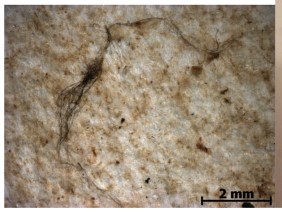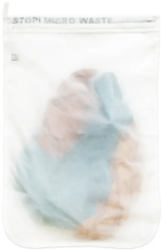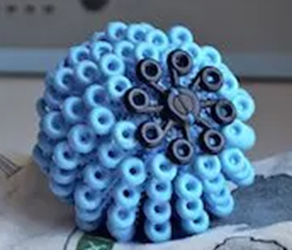Importance of Optimum Laundry System and Techniques for Fiber Cloths
Recently, the media has accused synthetic textile washing of causing fiber contamination. Clothing created from natural fibers is clothing made from animal or plant fibers (Acharya et al., 2021). Natural fibers include things like cotton, silk, linen, and wool. On the other hand, humans use a process called polymerization to create synthetic fabrics. Microfiber is a man-made substance. Split microfiber is the term for microfiber used for cleaning. Microfibers are 200 times thinner than a single human hair when split. These microfibers divide and create considerably more absorbent materials. They can get rid of a lot of microorganisms, even spores that are difficult to eliminate. Our clothing’s yarns are created by twisting together filaments. These filaments shed while being washed as a result of detergents, water, friction, and abrasion. Some fabrics shed more than others. A fabric that feels flat and smooth and is firmly woven with tightly twisted yarn sheds less than a fabric that is loosely woven with loosely twisted yarn (one that feels fluffy or fuzzy) (Okamoto, 2020).
Fiber cloths thread to environment
Microplastics arise from a variety of sources, including vehicle tires, plastic beads (including those used in skin-care products), synthetic fibers, and bigger pieces of plastic (like bottles) that shatter into smaller and smaller fragments. Shedding microplastics in the form of fibers, clothing, bedding, and other textiles—along with tire wear and road runoff—are increasingly recognized as important sources of the world’s plastic pollution. These microfibers enter our wastewater and eventually make their way to the environment after being stripped and carried away by friction and turbulence in the washing machine.
Microfiber pollution research is still in its early stages. Laundry was identified as a substantial source of plastic pollution in the world’s oceans just ten years ago in a groundbreaking survey of shorelines on six continents (Figure 1). The investigation specifically discovered plastic microfibers, which were microscopic polyester and acrylic threads similar to those found in textiles. The largest known source of marine microplastic pollution, according to current scientific estimates, is textiles, which are thought to be responsible for 35% of the microplastic pollution in the world’s seas (in the form of synthetic microfibers). The amount of microfibers entering the ocean every year is roughly 2.2 million tons.
Figure 1: Fiber retrieved during laundry (Gaylardeet al., 2021)
Two of the most well-known choices are the Cora Ball and the Guppyfriend washing bag. A microplastic filter that you attach to your washing machine is now available from Girlfriend Collective, which creates one of our favorite pairs of leggings from recycled polyester sourced partially from recycled PET (polyethylene terephthalate) bottles (albeit with some difficulty, according to reviews). Although these goods won’t be able to stop the vast worldwide problem of microplastic pollution on their own, they might help spread awareness and curb wastewater contamination on a smaller scale (Figure 2).
Figure 2: Fiber release during laundry of fiber cloths (Gaylardeet al., 2021)
The issue is that not only are those chemicals harmful on their own but they may also be transported to the environment by these fibers, extending their persistence. Additionally, these chemicals may have an impact on how long these fibers remain in the ecosystem. The longevity of plastics in the environment is one of their major drawbacks. As a researcher explained, if you alter these natural fibers to make them more resistant to environmental deterioration, they also become an issue.
Microfibers in Hotels and Hospitals
Microfiber is a popular material used in hospitals for cleaning and disinfecting surfaces. Hotel cleaning can contribute to microfiber pollution when microfiber fibers are released into the environment during cleaning and laundry processes. Microfiber fibers are extremely small and can easily become airborne, which can lead to them being inhaled by hotel staff and guests. However, there are a few potential problems with using microfiber in hospitals. One issue is that microfiber mops can release fibers during use, which can become airborne and potentially inhaled by hospital staff and patients. This can be a concern for those with respiratory issues. Another problem is that microfiber mops and cloths can become contaminated with germs and bacteria if they are not properly cleaned and disinfected between uses. This can lead to the spread of infection if the mops and cloths are used to clean multiple surfaces or rooms. Finally, microfiber mops and cloths can wear out quickly if they are used frequently or cleaned with harsh chemicals. This can lead to increased costs for hospitals as they need to replace the mops and cloths more often. To minimize these issues, hospitals should ensure that microfiber mops and cloths are properly cleaned and disinfected between uses, and that hospital staff is trained on the proper use and care of microfiber cleaning materials.
Additionally, microfibers can end up in the water supply if they are not properly collected and disposed of. Although keeping guest rooms clean has always been a high concern for hotels, COVID-19 has made future hotel visitors even more aware of the value of clean rooms. Healthcare facilities currently employ strict cleaning procedures aimed at preventing infections and lowering microorganisms, but there will be a trend toward advancing this practice in hospitality and other public settings as well. It is feasible to apply microfiber cleaning solutions at hotel properties in a financially viable and environmentally responsible manner. Microfiber may play a significant role in attempts to deliver a cleaner guest room experience.
There are a few ways that hotels and hospitals can minimize microfiber pollution:
- Properly maintain cleaning equipment: Regularly inspecting and maintaining cleaning equipment can help prevent fibers from being released into the air.
- Properly train staff: Staff who are trained on the proper use and care of microfiber cleaning materials will be less likely to release fibers into the air.
- Use alternative materials: Hospitals could also consider using alternative materials such as microfiber-free mops and cloths, which would eliminate the risk of microfiber pollution.
- Properly dispose of microfiber waste: Collect and properly dispose of microfiber waste to prevent it from entering the water supply.
However, it’s important to note that microfiber pollution is not only a problem in hospitals but also occurs in other settings such as households and industrial settings. They are also a form of microplastic pollution that affects the environment and wildlife.
Industrial solutions of microfiber cloths
There are a few different services and technologies that can be used to capture microfiber particles during hotel cleaning:
- HEPA filtration vacuums: High-efficiency particulate air (HEPA) filtration vacuums are designed to capture small particles, including microfiber fibers. They are commonly used in hotels and other commercial settings.
- Microfiber capturing mops: Some manufacturers have developed mops that are specifically designed to capture microfiber fibers, which can be easily removed and disposed of.
- Air filtration systems: Air filtration systems can be installed in hotel rooms and common areas to capture microfiber fibers that may be released during cleaning.
- Microfiber-free cleaning materials: Using microfiber-free cleaning materials such as cotton or cellulose-based alternatives can eliminate the risk of microfiber pollution.
It’s worth noting that while these services and technologies can be effective in capturing microfiber particles, proper training and maintenance of the equipment is crucial to ensure that they function correctly. Additionally, proper disposal of the captured microfiber particles is important to prevent them from entering the environment.
It is also worth noting that preventing the release of microfibers in the first place is the best course of action. This can be achieved by proper maintenance of cleaning equipment, and training of staff, as well as the use of alternative cleaning materials that don’t release microfibers.
Hazards of Domestic Solutions for Fiber Clothes
It is not advised since the cloth will emit poisonous particles into the air and water that are detrimental to human health as well as the environment or food chain for animals (eutrophication). In addition to being harmful to people and animals, microfiber can have a variety of negative environmental effects. Because microfiber is not biodegradable, it can be washed into water sources and drains, causing eutrophication of lakes and rivers (it does break up but only after a long time).
Microfiber is not biodegradable, it can have an impact on the food chain. When animals eat other living or dead things that have absorbed this material, they will swallow these fibers, which may create a variety of health issues for both the animals and those who eat their meat. Because it doesn’t include any dangerous chemicals that might hurt you while you sleep on it, organic bedding is safe for your health. Because organic fibers have not been chemically processed and don’t degrade quickly, they are also more durable than synthetic materials. Because organic sheets are recyclable and biodegradable and cause no harm to plants or animals when they are laundered in a washing machine, organic bedding is also beneficial for the environment. This helps lessen the amount of garbage that ends up in landfills. Researchers at The Mermaids identified aspects of the production of polyester and acrylic fabrics that may affect how many fibers may come off a completed item during washing or even normal use. They then suggested modifications, such as reducing the melting temperature used to create the yarn to increase its tensile strength and lessen the probability of breaking. However, modifying manufacturing methods comes with compromises, some of which can result in reduced production rates.
Role of laundry filter against hazards of fiber cloths
To stop microfiber shedding in laundry, you can buy one of two types of filters. The first is a filter that you place on the water exit of your washing machine to remove fibers before they reach sewage treatment facilities. The second is a washing-related accessory, like laundry bags made of woven monofilaments with tiny pores or balls that catch microfibers in the wash with your clothes.
Several studies (including one funded by the clothing company Eileen Fisher) show that both in-drum and external microfiber filters can, to differing degrees, minimize microfiber pollution in the wastewater system. Both types need routine cleaning to get rid of the debris that accumulates, and to keep plastics out of wastewater, those fibers must be thrown away rather than flushed down the drain. (Of course, the plastic will eventually wind up in landfills and might release chemicals into the environment over time)
Temporary Solutions in Laundry Operation
You might prefer a microfiber bag (which you fill with your cloths and throw in the machine) or a laundry ball if you have limited space surrounding your washing machine, your setup sounds like too much of a DIY job, you rent, do your laundry at a laundromat, or you’re on a smaller budget (which goes into the drum with your load).
Laundry Bags
There are a few microfiber-filtering washing bags available if you’re thinking about buying one; the Guppyfriend is the most popular. The material used to make it is woven monofilament, a single polyamide filament that resembles a fishing line but does not break down into threads as the yarn does. It feels smooth, almost slippery, and similar to a windbreaker thanks to the material. Outdoor merchants like Patagonia and REI as well as directly through the website sell it. The Guppyfriend safeguards delicate in the wash, just like other wash-cycle laundry bags (including ones that don’t make that claim about lowering microplastic pollution). Since it has been on the market the longest—since 2017—the Guppyfriend appears to have undergone the most testing and study of any of its rivals (Okamoto, 2020).
Figure 3: Laundry Bags for microfiber filtering {Okamoto, 2020 #28}
Laundry Balls
Cora Ball offers commercial and targeted solutions to the microplastic issue. It is a grapefruit-sized, pine-cone-like plastic ball with soft, doughnut-shaped plastic discs covering its spines to prevent snagging on your clothing. The Cora Ball was the third most efficient device out of the six evaluated in the University of Plymouth study, eliminating microfibers by roughly 31% as opposed to 54% for the Guppyfriend. It may be more crucial to think about what you wash—and how—since neither gadget is flawless but both have been demonstrated in testing to minimize microfiber shedding into wastewater.
To prevent the discharge of microfibers into the waste pipe, modern washing machines must be factory-fitted with the appropriate filters. The capacity of various pore-sized filters to lessen microfiber release was compared by Browne et al. (2020). Although discharged PE fiber mass was successfully reduced by micron-sized filters by over 65%, filtered effluent still included up to 30% of the original fiber mass. McIlwraith et al. (2019) used the Lint LUV-R to catch 87% of all microfibers, compared to 26% using the Cora Ball. The effectiveness of these devices is influenced by the kinds of cloths being cleaned as well as the particular circumstances and mechanics of the washing process.
Figure 4: Laundry Balls (Cora) for microfiber washing
Ozone disinfection as a modern technology
Although hard, the removal of microfibers at wastewater treatment facilities is being studied. This is because, to avoid discharge into the environment, the microfibers would need to be removed from both effluent and sludge. They advised that controlling the source, particularly getting rid of fibers from laundries, was the best strategy to decrease fiber effluents. This does seem to be the best option, albeit it will require focused research on non-fiber-releasing materials and better air and water filters in washing facilities.
In modern technologies, ozone disinfection is considered one of the best approaches to tackle the microfiber problem. P.N. Humphreys and colleagues from Huddersfield University wrote in a peer-reviewed report that was published in the Journal of Infection Prevention in 2012 that “the data supports the position that JLA’s OTEX system is an effective approach for the re-cycling of microfiber cloths without any detrimental impacts on MF performance up to 350 OTEX cycles.” After extensive research and development, a novel wash procedure was created and tested at the QE2 Hospital in Welwyn Garden City with the help of the NHS and ISS Mediclean. Following six months of microbiological examination of mops and cloths, it was discovered that none of the post-wash mops and cloths had any harmful bacteria, proving that even cold water may effectively disinfect items. Since hot water is not required, both water and power usage are drastically reduced. Additionally, there is no need for the energy needed to heat to thermal temperatures and offer the required hold times. As a result, ozone reduces the wash process’ overall carbon footprint and upholds the microfiber’s integrity. “Technology’s importance in professional cleaning should not be ignored. The most recent OTEX research was conducted in conjunction with De Montfort University, and after extensive testing, it was determined that the OTEX washing system completely eradicates all signs of COVID-19. Knowing that microfibers and textiles, including beds, linen, and even uniforms, can be washed at a low temperature while entirely eradicating all traces of the virus is a reassurance that is more crucial than ever for any place where infection control is crucial.
Conclusions
The laundry of the fiber cloths requires special care to avoid possible production of hazardous material after cleaning. Inappropriate handling of fiber cloth laundry may create hazardous threats to the environment. The domestic solutions to handle microfiber pollution are very hazardous to the environment and should be restricted. The inclusion of filters in the laundry system can be considered a temporary solution to the fiber-related contamination in the laundry water. The laundry bags are made of woven monofilaments with tiny pores or balls that catch microfibers in the wash with your clothes. Modification in the washing procedure, washing machine, and involvement of the solutions may also provide a solution to problems that arise in the laundry of fiber cloths.
References
Okamoto, K. (2020). Your Laundry Sheds Harmful Microfibers. Here’s What You Can Do About It. Retrieved 1/7/2023, 2023, from https://www.nytimes.com/wirecutter/blog/reduce-laundry-microfiber-pollution/
Acharya, S., Rumi, S. S., Hu, Y., & Abidi, N. (2021). Microfibers from synthetic textiles as a major source of microplastics in the environment: A review. Textile Research Journal, 91(17-18), 2136-2156.
Gaylarde, C., Baptista-Neto, J. A., & da Fonseca, E. M. (2021). Plastic microfiber pollution: how important is clothes’ laundering?. Heliyon, 7(5), e07105.
Browne, M. A., Ros, M., & Johnston, E. L. (2020). Pore-size and polymer affect the ability of filters for washing-machines to reduce domestic emissions of fibers to sewage. Plos one, 15(6), e0234248.
McIlwraith, H. K., Lin, J., Erdle, L. M., Mallos, N., Diamond, M. L., & Rochman, C. M. (2019). Capturing microfibers–marketed technologies reduce microfiber emissions from washing machines. Marine pollution bulletin, 139, 40-45.




















